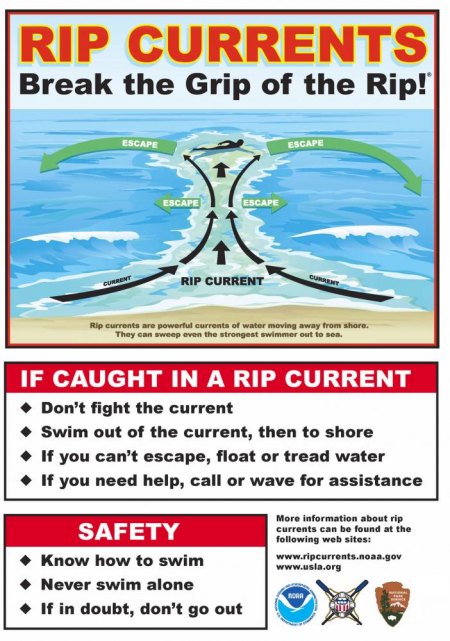High Rip Current Risk on Ocracoke
A swimming-related fatality occurred off Cape Hatteras National Seashore, near Ocracoke Island’s Pony Pen beach access, at around 5:10 pm on Monday, August 14.
The swimmer, a 63-year-old male visiting from out-of-state, was reported to have been caught in a very strong rip current while attempting to rescue another swimmer in distress. Cape Hatteras National Seashore Law Enforcement Rangers, Hyde County deputies, lifeguards, Ocracoke Emergency Medical Services, and the Ocracoke Fire Department all responded to the incident and attempted to revive the male swimmer, but the attempts were unsuccessful. The other swimmer was able to safely return to shore.
Outer Banks Group Superintendent David Hallac said, “our thoughts are with his family and friends during this difficult time.”
NOAA Reports That Ocracoke's Rip Current Risk is HIGH
PRECAUTIONARY/PREPAREDNESS ACTIONS... A high risk means wind, wave and tide conditions support the development of powerful or numerous rip currents along the beaches. It is recommended that you stay out of the water. All beach goers should remain aware of inherent dangers when entering the surf including strong rip currents, swift longshore currents, pounding shore break and shallow sand bars. It is safest if you swim at a guarded beach and always heed the advice of lifeguards and beach patrol.
RIP CURRENTS ARE POWERFUL CHANNELS OF WATER FLOWING QUICKLY AWAY FROM SHORE...WHICH OCCUR MOST OFTEN AT LOW SPOTS OR BREAKS IN THE SANDBAR AND IN THE VICINITY OF STRUCTURES SUCH AS GROINS...JETTIES AND PIERS.
HEED THE ADVICE OF LIFEGUARDS AND THE BEACH PATROL. PAY ATTENTION TO FLAGS AND POSTED SIGNS POSTED NEAR BEACH ACCESS POINTS AND LIFEGUARD STATIONS.
IF YOU BECOME CAUGHT IN A RIP CURRENT...DO NOT PANIC. REMAIN CALM AND BEGIN TO SWIM PARALLEL TO SHORE. ONCE YOU ARE AWAY FROM THE FORCE OF THE RIP CURRENT...BEGIN TO SWIM BACK TO THE BEACH. DO NOT ATTEMPT TO SWIM DIRECTLY AGAINST A RIP CURRENT...SINCE IT CAN EXHAUST AND EVEN KILL THE STRONGEST SWIMMER. SHORE BREAK OCCURS WHEN WAVES BREAK DIRECTLY ON THE BEACH.
THE MOST COMMON INJURIES WITH STRONG SHORE BREAK ARE NECK AND BACK INJURIES... WHICH MOST OFTEN OCCUR WHEN THE POWERFUL SURF THROWS A SWIMMER OR SURFER HEAD FIRST INTO THE BOTTOM. IT IS EXTREMELY IMPORTANT TO PROTECT YOUR HEAD AND NECK WHENEVER YOU ARE IN BREAKING WAVES BY KEEPING YOUR HANDS IN FRONT OF YOU AT ALL TIMES.






